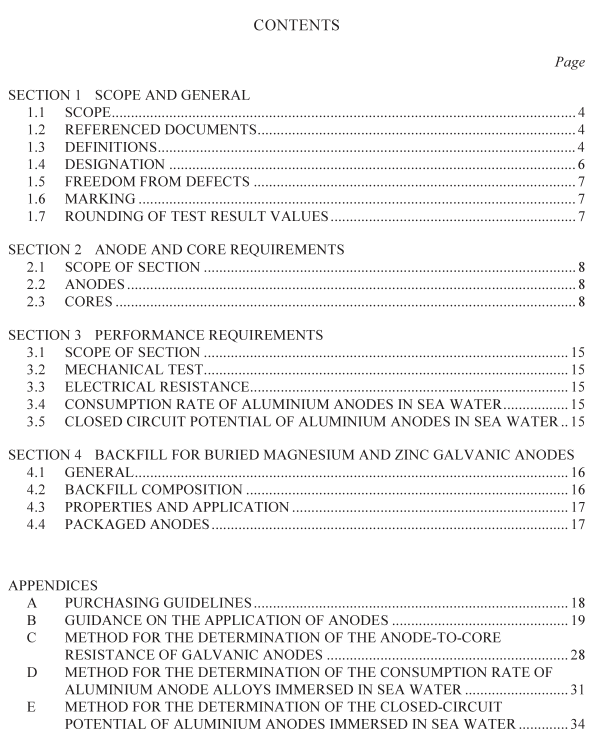AS 2239 pdf download – Galvanic (sacrificial) anodes for cathodic protection

AS 2239 pdf download – Galvanic (sacrificial) anodes for cathodic protection
1.3.2 Anode backfill
Material surrounding and in contact with a buried anode to maintain or improve itsperformance.
1.3.3Anode consumption rate
The rate of alloy mass consumption for a given current output over a given period; normallystated in kilograms per ampere year.
1.3.4 Anode core
A metal insert (usually steel) either cast into the anode or extruded with the anode toprovide mechanical strength and attachment.
1.3.5 Cathode
The structure that is to be protected by cathodic protection.1.3.6Cathodic protection
The prevention or reduction of corrosion of metal by making the metal the cathode in agalvanic or electrolytic cell.
1.3.7Closed circuit potential
The potential of an anode connected to a structure when passing current; normally measuredagainst a reference electrode in a particular environment.
1.3.8 Copperlcopper sulfate (Cu/Cuso;) reference electrode
A reference electrode consisting of copper in a saturated solution of copper sulfate.1.3.9 Current capacity
The total current flow available from an anode of given mass of alloy; normally expressedas ampere years per kilogram. This is the inverse of the anode consumption rate.
1.3.10 Current density (at anode)
Current output of anode divided by the anode surface area.1.3.11 Current density (at cathode)
Current flowing into cathode divided by the cathode surface area.1.3.12 Current density (at coated cathode)
Total current flow into cathode divided by the total surface area of the structure.1.3.13 Driving potential
The difference between the open circuit potentials of the anode and the structure.1.3.14 Electrolyte
A liquid, or the liquid component in a composite material such as soil, in which electriccurrent may flow by ionic charge transfer.
1.3.15 Galvanic action
A spontaneous electrochemical cell reaction in which a metallic anode in a dissimilar metalcouple corrodes.
1.3.16Galvanic anode
An electrode used to protect a structure by galvanic action.
1.3.18 Gross anode packaged weight
Total mass of a packaged anode, including core, cable,connection and backfill.1.3.19 Net anode mass
Mass of actual anode alloy.1.3.20 Open circuit potential
The potential of an anode when not connected to a structure; normally measured against areference electrode in a particular environment.
1.3.21 Packaged anode
Either a magnesium or zinc anode placed, with backfill, in a calico bag or other approvedcontainer to provide a uniform low resistivity environment for the anode.
1.3.22 Reference electrode
An electrode which has a stable potential in one or more electrolytes at a given temperature,thus enabling it to be used for the measurement of other electrode potentials.
1.3.23 Resistivity
Resistance per unit length through a unit area cross-section, (ohm.m).1.3.24 Silver/silver chloride reference electrode (Ag/AgCl)
An electrode consisting of silver,coated with silver chloride,in an electrolyte containingchloride ions.
1.3.25Test anode
A prepared anode test piece, made from a test specimen by a mechanical operation.1.3.26 Test sample
A portion of material or a group of items selected from a batch or consignment by asampling procedure.
1.3.27 Test specimen
A portion of material or a single item taken from the test sample for the purpose of applyinga particular test.
1.4 DESIGNATION
1.4.1 Anodes
The anode designation shall consist of the following components:
(a) A prefix number or numbers indicating the net alloy mass.
(b) A letter indicating the alloy material as follows:
(i) A……………………………………. aluminium.
(ii) M ………………………………….. magnesium.
(iii) Z …………………………………………….. zinc.
(c) The series number of the alloy.
Example of designation: 10Z1 indicates a 10 kg anode of alloy Z1, the first alloy in the series.
1.4.2 Backfill
Backfill surrounds for anodes shall be designated in accordance with their composition, as follows:
(a) B1 …………………………………. calcium bentonite/gypsum.
(b) B2 …………………………………. sodium bentonite/gypsum.
(c) B3 …………………………………. as for Items (a) or (b) with additions of sodium sulfate.
1.5 FREEDOM FROM DEFECTS
Anodes shall be produced from primary metal alloys. No secondary metal or scrap shall be used, with the exception of house generated scrap from rejected anodes during the forming process.









